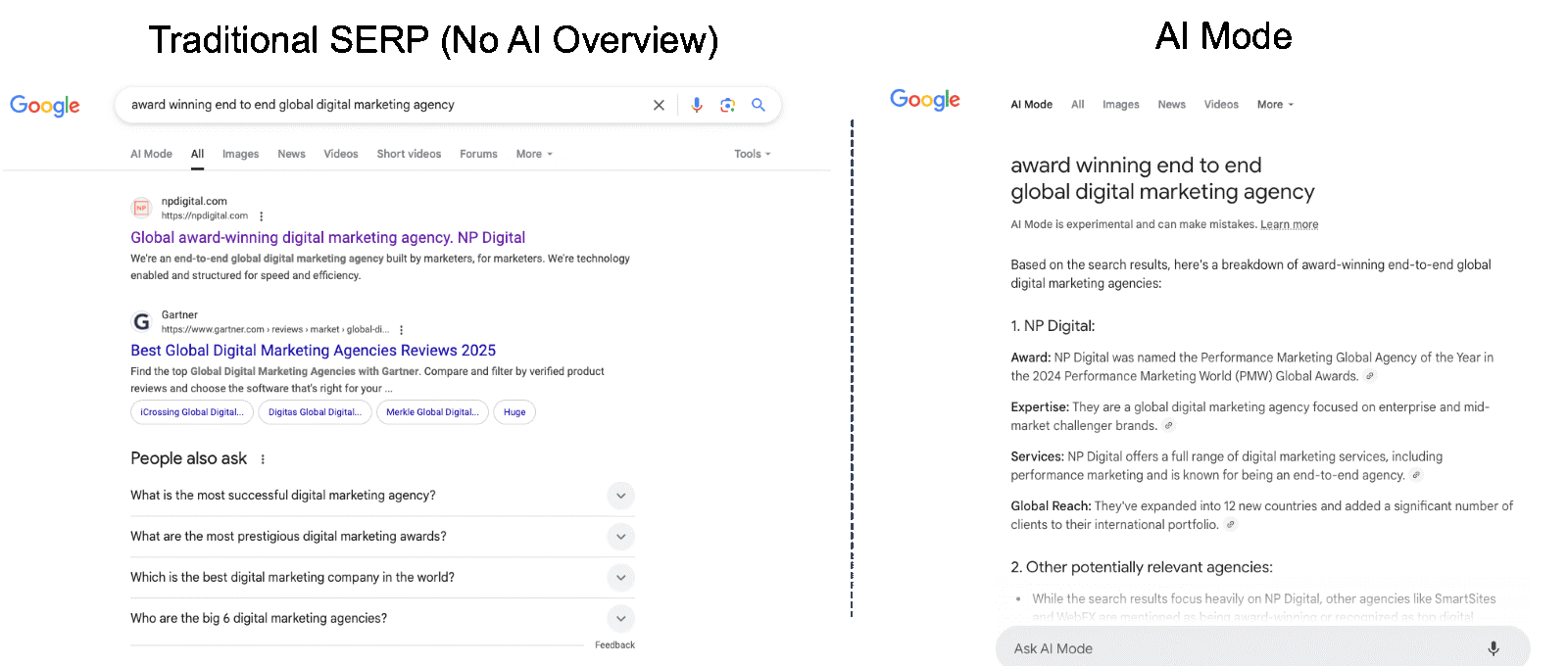Key Takeaways
Google AI Mode is a new search feature that enhances Google’s AI-powered capabilities.
Unlike AI Overviews, AI Mode works on all search queries and allows follow-up questions.
Powered by Gemini 2.0, it provides conversational, ChatGPT-like responses.
AI-driven search is changing SEO strategies, and businesses must adapt now.
Referral traffic from generative AI grew 123% in just six months.
This shift means new opportunities for businesses to gain visibility and traffic.
Google AI Mode is Here – Are You Ready?
Google just launched its newest AI-powered search feature—AI Mode—and while not everyone has access yet, businesses need to prepare now.
AI Mode is Google’s answer to ChatGPT and other AI-driven search tools. Unlike Google’s previous AI Overviews, AI Mode appears as a dedicated search option, just like Images, Videos, and Shopping.
Key Takeaways
Google AI Mode is a new search feature that enhances Google’s AI-powered capabilities.
Unlike AI Overviews, AI Mode works on all search queries and allows follow-up questions.
Powered by Gemini 2.0, it provides conversational, ChatGPT-like responses.
AI-driven search is changing SEO strategies, and businesses must adapt now.
Referral traffic from generative AI grew 123% in just six months.
This shift means new opportunities for businesses to gain visibility and traffic.
Why Does This Matter?
✅ Google dominates 93.57% of the search market, but AI-powered search is rapidly gaining ground. ✅ ChatGPT alone now handles an estimated 37.5 million search-like queries per day. ✅ Generative AI referral traffic increased by 123% in just six months.
AI Mode could redefine how businesses rank, get discovered, and generate leads—but only if they adapt.
What is Google AI Mode & How Does It Work?
Unlike traditional search, AI Mode is a conversational AI experience built on Google’s Gemini 2.0 model.
🔹 Works on all search queries, not just select ones like AI Overviews.
🔹 Allows users to ask follow-up questions, refining their search in a chatbot-style conversation.
🔹 Provides more detailed and AI-generated insights beyond regular search results.
Currently, to access AI Mode, you must:
Be in the U.S.
Be over 18 years old
Opt-in via Google Labs
However, just like AI Overviews went mainstream, AI Mode is expected to expand worldwide soon.

How Google AI Mode Impacts SEO & Search Traffic
Google’s AI search update is disrupting traditional SEO. Here’s what’s changing:
1️⃣ AI-Powered Answers May Reduce Clicks
Instead of directing users to websites, AI Mode provides in-depth answers directly on Google. Businesses that rely on organic clicks must adjust their strategy.
🚀 Solution: Optimize for AI search by creating high-quality, authoritative content that AI Mode sources from.
2️⃣ AI Mode Can Be a Traffic Source
Despite fewer clicks, AI Mode does link to sources. A study by NP Digital found that AI-driven search referrals grew by 123% from September 2024 to February 2025.
🚀 Solution: Businesses must optimize their content to appear in AI-generated responses.
3️⃣ Conversational Queries Change Keyword Strategy
AI Mode allows users to ask follow-up questions, meaning traditional keyword optimization isn’t enough.
🚀 Solution: Focus on long-tail keywords and natural language that align with conversational search patterns.
How Businesses Can Leverage Google AI Mode
If your business wants to stay ahead of AI-driven search, here’s what to do:
✅ Optimize for AI-Powered Search
Use structured data so AI Mode can easily pull your content.
Answer common industry questions concisely.
Ensure EEAT (Experience, Expertise, Authority, Trustworthiness) is strong.
✅ Target Conversational Queries
Focus on how-to guides, FAQs, and problem-solving content.
Use long-tail keywords (e.g., “How businesses can leverage AI search”).
✅ Monitor AI-Driven Referral Traffic
Use Google Search Console & Analytics to track traffic from AI-powered searches.
Compare traditional search vs. AI Mode referrals.
✅ Leverage AI for Marketing
AI-driven search isn’t just about getting found—it’s also about marketing smarter:
Create AI-friendly content that ranks in Google’s AI responses.
Use AI tools for content creation and audience research.
Implement AI-driven SEO strategies.
FAQs
❓ Is Google AI Mode available to everyone?
Not yet! Right now, you must be in the U.S., over 18, and opt-in via Google Labs.
❓ Will AI Mode replace traditional Google Search?
Unlikely. AI Mode is an enhanced search feature but doesn’t replace Google’s core search algorithm.
❓ How can businesses optimize for AI Mode?
Focus on structured data, long-tail keywords, and conversational content that aligns with AI-driven search queries.
❓ How does AI Mode impact SEO rankings?
SEO strategies must evolve. AI Mode can reduce organic clicks but also increase AI-driven referral traffic if optimized correctly.
Google AI Mode isn’t the future—it’s the NOW of search. Businesses that adapt early will gain an edge over competitors still relying on outdated SEO strategies.
If you want to be our next success story and have Digital Marketing All do your marketing for you, click here to book a call! 🚀
 Add Row
Add Row  Add
Add 








Write A Comment